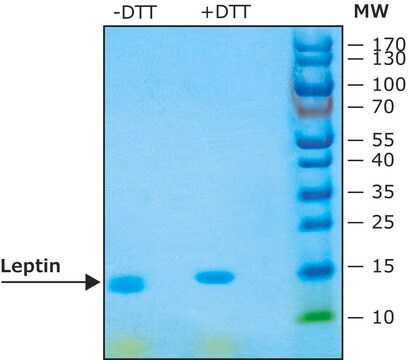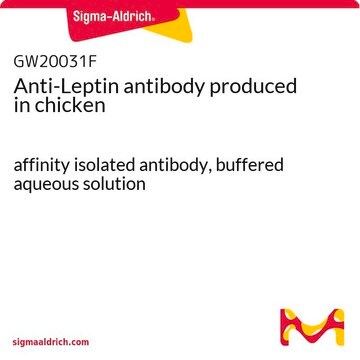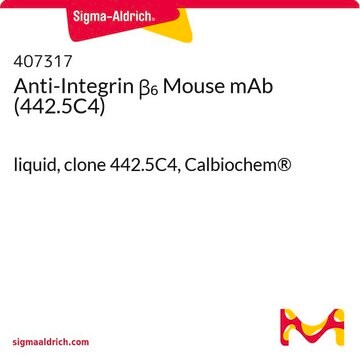429700
Leptin, Human, Recombinant, E. coli
Sinonimo/i:
Leptin, Human, Recombinant, E. coli, rhOB
Autenticatiper visualizzare i prezzi riservati alla tua organizzazione & contrattuali
About This Item
Prodotti consigliati
Origine biologica
Escherichia coli
Livello qualitativo
Descrizione
Merck USA index - 14, 5443
Sterilità
non-sterile
Saggio
≥97% (SDS-PAGE)
Stato
lyophilized
Produttore/marchio commerciale
Calbiochem®
Condizioni di stoccaggio
OK to freeze
Impurezze
≤1.0 EU/μg Endotoxin (EU/μg leptin)
Condizioni di spedizione
ambient
Temperatura di conservazione
−70°C
Categorie correlate
Descrizione generale
Recombinant, human leptin expressed in E. coli. Leptin was originally identified as a protein product of the mouse obese gene. Mice with mutations in the obese gene that block the synthesis of leptin have been found to be obese and diabetic and to have reduced activity, metabolism and body temperature. cDNA clones encoding leptin have been isolated from human, simian, mouse and rat cells. Human leptin shares approximately 84% sequence identity with the mouse protein. Human leptin cDNA encodes a 167 amino acid residue protein with a 21 amino acid signal sequence that is cleaved to yield the 146 amino acid mature protein. The expression of leptin mRNA has been shown to be restricted to adipose tissue.
A high-affinity receptor for leptin (OB-R) with homology to gp130 and the G-CSF receptor was subsequently cloned. The OB-R cytoplasmic domain transduces the leptin signal through the JAK-STAT pathway. Although OB-R mRNA was initially shown to be expressed predominantly in the choroid plexus and in the hypothalamus, more recent data also revealed the expression of this receptor in endothelial cells (Ecs). Furthermore, the angiogenic activity of leptin has been demonstrated both in vitro and in vivo, suggesting a physical mechanism whereby leptin-induced angiogenesis may facilitate increased energy expenditure.
A high-affinity receptor for leptin (OB-R) with homology to gp130 and the G-CSF receptor was subsequently cloned. The OB-R cytoplasmic domain transduces the leptin signal through the JAK-STAT pathway. Although OB-R mRNA was initially shown to be expressed predominantly in the choroid plexus and in the hypothalamus, more recent data also revealed the expression of this receptor in endothelial cells (Ecs). Furthermore, the angiogenic activity of leptin has been demonstrated both in vitro and in vivo, suggesting a physical mechanism whereby leptin-induced angiogenesis may facilitate increased energy expenditure.
Azioni biochim/fisiol
ED₅₀ = 0.4-2 ng/ml as measured by its ability to induce proliferation of leptin-dependent rOB-R transfected murine BAF3 cells
Attenzione
Toxicity: Standard Handling (A)
Stato fisico
Lyophilized from a sterile filtered solution in PBS.
Ricostituzione
To reconstitute lyophilized leptin, add 15 mM sterile HCl (0.5 ml/1 mg vial or 2.5 ml/5 mg vial) to the vial. After the protein is completely dissolved, add 7.5 mM sterile NaOH (0.3 ml/1mg vial or 1.5 ml/5 mg vial) to bring the pH to ~5.2. Lyophilized samples are stable for at least six months at -70°C. Upon reconstitution, this cytokine can be stored under sterile conditions at 4°C for one month or at -70°C for three months without detectable loss of activity. Avoid repeated freeze/thaw cycles of reconstituted solutions.
Altre note
Anderwald, C., et al. 2002. Mol. Endocrinol.16, 1612.
Ookuma, M., et al. 1998. Diabetes 47, 219.
Campfield, L.A., et al. 1995. Science 269, 546.
Halaas, J.L., et al. 1995. Science 269, 543.
Pelleymounter, M.A., et al. 1995. Science 269, 540.
Zhang, Y., et al. 1994. Nature372, 425.
Ookuma, M., et al. 1998. Diabetes 47, 219.
Campfield, L.A., et al. 1995. Science 269, 546.
Halaas, J.L., et al. 1995. Science 269, 543.
Pelleymounter, M.A., et al. 1995. Science 269, 540.
Zhang, Y., et al. 1994. Nature372, 425.
Note legali
CALBIOCHEM is a registered trademark of Merck KGaA, Darmstadt, Germany
Codice della classe di stoccaggio
11 - Combustible Solids
Classe di pericolosità dell'acqua (WGK)
WGK 1
Certificati d'analisi (COA)
Cerca il Certificati d'analisi (COA) digitando il numero di lotto/batch corrispondente. I numeri di lotto o di batch sono stampati sull'etichetta dei prodotti dopo la parola ‘Lotto’ o ‘Batch’.
Possiedi già questo prodotto?
I documenti relativi ai prodotti acquistati recentemente sono disponibili nell’Archivio dei documenti.
Il team dei nostri ricercatori vanta grande esperienza in tutte le aree della ricerca quali Life Science, scienza dei materiali, sintesi chimica, cromatografia, discipline analitiche, ecc..
Contatta l'Assistenza Tecnica.








